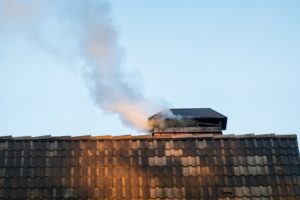Your chimney serves as a channel that escorts smoke from the fireplace inside your home up and out into the outside air. The damper of a chimney is a metal flap that serves as a door between your fireplace and your chimney. Near your fireplace, you should see a lever or knob that allows you to open and shut this damper as needed.
When you use your fireplace, you should open the chimney damper to allow smoke to escape out of the flue. But when not in use, you can close the damper to stop drafts from the outdoors from entering your home. Read on to learn more about this important feature of your chimney.

Do I Need a Chimney Damper?
While your fireplace and chimney can function without a damper, you should have a damper installed to ensure safety and efficiency when you build a fire. You can have greater control over the fire in your home with this tool, for instance. Partially closing the damper will reduce the intensity of your fire for a more efficient burn.
You can also improve your environmental footprint with this chimney tool. The damper will stop drafts of outdoor air from flowing back into your house and disrupting your interior temperature. This can help your heating and cooling systems work regularly and without disruption.
Then you will not have to worry about a spike in the cost of your utility bill. You will also be able to keep out critters, debris, and other external threats that could try to come down your chimney and into your house.
How Do I Install a Chimney Damper?
Most fireplaces already have a chimney damper installed. Look for a switch near the fireplace and make sure it is in the correct open or closed position, depending on if you are using the chimney or not.
Some old-fashioned fireplaces might not have a damper, in which case you can install one. You should consult with a chimney sweep expert to discuss the dimensions of the chimney to confirm you get the right type of damper. A damper within the flue is easy to secure into place above the smoke chamber but check with your chimney expert if you have questions.
You can also choose a top chimney damper. This will feature a seal at the top of the chimney rather than above the fireplace within the chimney. This requires roof access but is also easy to install.
What Is the Difference Between a Damper and a Cap?
As mentioned, a damper can go within the flue or on top of the chimney. So you may then wonder how this top-sealing damper differs from a chimney cap. The chimney cap refers to a metal cover over the top of the chimney.
The cap will prevent debris and rainwater from entering the chimney and posing a risk to its structure. But this cap purposely allows heat and smoke to escape at all times. This means the device does not stop drafts from entering the flue.
A damper can open and close, a feature a cap does not have. And the damper will therefore shield against drafts. A chimney expert can combine the damper and cap into one structure if needed.
